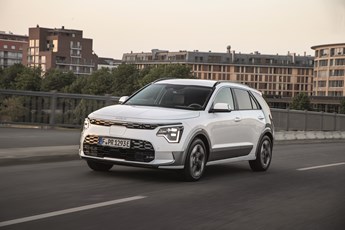We use cookies to ensure that we give you the best experience on our website. If you continue without changing your settings, we will assume that you are happy to receive all cookies on the Business Car website. However, if you would like to, you can change your cookies at any time

The start point for the best source of fleet information |
First drive: Kia Niro
Date: 26 August 2022 | Author: Martyn Collins

|
|
||||||||||||||||||||
Kia's first Niro burst onto the market in 2016 and was the Korean company's first hybrid crossover. That wasn't the end of Niro development, as a full EV version, with an impressive 282-mile range, followed in 2019. The e-Niro went on to be the second-best selling EV behind the Tesla Model 3.
Despite all this success, and with over 70,000 finding UK homes, there's now an all-new Niro, which is available - as before - in EV, PHEV and HEV powered versions.
The new model is longer, wider and taller, but the basic crossover hatchback shape remains unchanged. That's where the similarities with the outgoing, rather tame, original end. At the front, there are two different designs. One for HEV and PHEV versions and the other for the EV, with its central charging point. Both have large and angular headlamps - with unusual heart-beat design daytime running lights. There are also the slim upper and larger lower front grilles, plus the double cowl bonnet. At the side, there are bold, contrasting wheel arches, side trims and C-pillars. The latter are the cleverest part of the new Niro's design, as they sit slightly proud of the body and funnel air around the rear of the car. Another distinctive rear design feature are the boomerang rear lights, which like the rear design overall, reminds us of the second-generation Ford Focus.
To sum up, the new Niro has its own sense of style and looks interesting when compared to rivals.
Inside, the influence of the range topping EV6 is obvious. The dashboard of the top models that we drove, was made up of 10.25in display and infotainment screens and plenty of polished piano black trim. There is also the tall centre console and angular door cards. The new Niro also gets the clever multi-mode panel under the infotainment screen, which can switch between the infotainment and ventilation.
Quality feels a step up from the old Niro, plus with 20mm of extra wheelbase, the interior is as spacious as it always has been - and there's still the 475-litre boot - which can be extended with the rear split/fold seat. Some of the plastics lower down the interior are scratchy and the infotainment was a bit glitchy on the cars we drove. However, we were informed that they were late pre-production models, and these problems should be fixed on production models.
On top of the Niro EV which we spent the most time with, we also drove the other HEV and PHEV versions. The HEV Hybrid is powered by a revised version of the 1.6-litre GDi petrol engine from the outgoing car, assisted by an electric motor equalling 139hp. Starting in electric mode, this Niro is a smooth, refined drive from the start. Then, when the roads open up out of town, it neatly switches to petrol power. In fact, this was the most comfortable Niro we drove, and it's expected to be the second biggest seller in the UK, alongside the EV.
The most significant powertrain change for the PHEV is that the battery is larger, growing from 8.9kWh to 11.1kWh, and with it the EV range is usefully increased from 36 to 38 miles - 40 even, if you go for the entry level 2 equipment grade. The PHEV also has BIK rates as low as 8%. Once the battery is empty, it can be recharged via the left-hand side wing socket on a 7kW charger taking up to 2.5 hours.
On top of the larger battery, the Niro PHEV combines an 83hp electric motor with the 1.6-litre GDi petrol, with total power equalling 180hp. The PHEV again is refined from the off, and is a tidy, if unremarkable drive. Perhaps less urgent than the Niro HEV, but the transitions between petrol and electric power are generally smooth. In fact, the engine only gets a bit unruly if accelerating hard.
With the positive reputation of its predecessor, 2% BIK figure and 285-mile range, it's no surprise Kia UK expect sales and market share of the Niro EV to grow with the new model. On the move, it drives much the same as the outgoing e-Niro. However, the new K3 architecture equals a generally more comfortable ride - although some undulations can still unsettle this Niro at speed. If you like one-pedal driving, the iPedal works very well. If not, there are three regen levels available via the steering wheel paddles.
There are 'Normal', 'Sport' and 'Eco' driving modes. We found 'Normal' the best for everyday use; it's a shame then that despite the long-range, it takes a long time to recharge. The Niro EV can be fast charged, but 43 minutes from 10-80%, is quite far behind rivals. A full charge via a 7kw wall box takes over 10 hours, too. Overall, the Niro EV is a tidy, but not sporty drive - much like the last one.
So, the new Kia Niro adds a welcome dose of style to a well-equipped, spacious, and good-to-drive package. The Niro EV is justifiably one of the best affordable EVs on-sale today.
Kia Niro EV 3 Long Range Automatic
P11D: £38,940
Residual value: 47.8%
Depreciation: £20,312
Fuel: £3,570
Service, maintenance and repair: £1,445
Cost per mile: 42.78p
Range: 285 miles
CO2 (BIK %): 0% (2%)
BIK 20/40% a month: £12/£25
Luggage capacity: 475 litres
Battery size/power: 64.8kWh/204hp
Verdict |
8/10 |
|||
 |
|
 |
|
|











